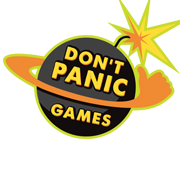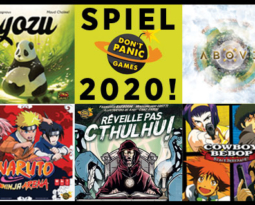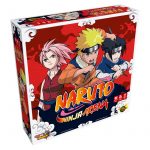Fighters of the Pacific : Frank Garibaldi interview

- Hello, I’m Isabelle from Don’t Panic Games and I’m here today with Frank Garibaldi to talk about Fighters of the Pacific.So, Frank, can you introduce yourself ? Who are you ?
 Hello Isabelle,
Hello Isabelle,
I’m Frank Garibaldi, designer of the game Fighters of the Pacific. I’m 43 years old, married with two children, an 11-year-old daughter and a 9-year-old boy. We live in Marseilles under a good Provençal sun and under the benevolent gaze of the Bonne Mère (Good Mother, a nickname for the famous cathedral overlooking the city)!
I am a player at heart and a creator. I love playing with my family and I admit that it has always been a part of me. As a child, I had fun modifying and improving the games in my MB collection.
Later, around my teens, I played a lot of role-playing games with my friends and all the fantasy miniature games that everyone knows. I remember making a World War II game with a friend at the time with some miniatures. We spent a lot of time playing this game and writing the rules.
ponfzlnfkzlfenknkl
- Can you tell us in a nutshell how the game works ?
Fighter of the Pacific is a game about air combat during World War II.
The theatre of operation is set in the Pacific covering the period of 1942. The game is intended for 2 players and has a fast-paced, nimble system where every step in the initiative can have a fatal outcome.
In FIPA each of the camps must accomplish diverging and varied objectives. Bombing islands, torpedoing ships, conducting rescue, reconnaissance at sea, etc. Players lead groups of fighters, bombers, ships. Each aircraft is moved either as a group or individually. If one of them moves and an opposing aircraft is in its field of fire, it fires. The opponent can react by performing a dodge maneuver if it was not activated during the turn. Otherwise, it will suffer the damage or be destroyed. In FIPA, gaining the initiative is especially important, it often allows to a player to take control of the battle. It is calculated very simply: 1 point for each group of aircraft or aircraft alone at high altitude, 2 points for each plane in a group or alone at low altitude, and 1 point per plane with a damage token. Each turn, the opponent with the fewest points keeps or takes the initiative. One last thing that seems important to me: in this game there are no dice but many, many planes.
- Can you tell us why you chose to work with publishing house Capscicum and with Didier?
My choice was Didier simply because I had seen his game Fleet Commander which was launched through crowdfunding on the Kickstarter platform, and which had received an excellent reception from the players. Didier did a great job on the Fleet Commander project and I thought he might be interested in my project and help me launch it. Afterall, from ships to planes, the editorial line is close!
I contacted Didier and luckily, he was interested in the theme and he wanted to know more.
After a few exchanges by email and phone, we were able to meet to test the beta version of Fighters of the Pacific. Didier was won over, then recommended several modifications that could be made, I remember, coming back on the train from the Cannes games festival in February 2020!
- I guess the game wasn’t done in a day. How long did it take to make this game ?
Obviously, the culmination of a game is not done in a day. It took me several years to get a result that matched what I wanted the game to be.
If I were to say how many years, I would say at least 5 and that would not be far from the truth.
- What were the main steps ?
There were a lot of elements involved in the creation of FIPA. I can’t really give a precise order because ideas can come and go at any time and in any order.
I would say it was above all the theme of the game that was closest to my heart. After establishing the scale of the game, came the question of the size of the board, then that of the format of the grid (squares or hexagons), and finally the rules of the game. Once all this was put together, it was necessary to make a first carboard prototype…
The last test was public testing, necessary modifications, and new game tests until completion. The road is awfully long until you get to be published, with times of doubt but it’s also good times when people find your job great and have fun playing your game.
- Did you encounter any difficulties ? What were they ?
Yes, so many! Each step was a challenge: the first was technical, how to implement an acceptable prototype. For example, how to make a game board, how to create the miniatures of the planes and so on. The Internet was of great use to me for the GIMP tutorials. At the beginning, when you’re alone on the project you must show a lot of patience and ingenuity. And at the same time, you have the search for historical documentation. I spent countless hours searching the net, reading historical documents, searching for technical documentation on airplanes, comparing their characteristics, writing tables under Excel to identify each one’s strengths and weaknesses. I also read quite a few stories of veteran pilots and the tactics used in air combat. All this to be able to build the rules based on a well-founded historical narrative.
- Any ideas that you tried to put into practice and that you had a hard time realizing? Why and how did you finally integrate it into the game ?
Initially, the first prototype contained a lot of aircraft but the management was complicated and yet I felt I was on the right track. We just had to simplify a few rules. I focused instead on individual aircraft management in the form of miniatures. I was moving away from my original idea, the one that inspired me to create this game. After meeting Didier and having him test the game, he immediately told me “it needs a lot of planes with a big game board and ultra-simple rules”. Having a lot of planes in each game, that’s the feeling of a fierce air battle guaranteed with planes everywhere, occupying all the space. What I learned from this meeting with him was that my first idea was the right one. So, I went home to get back to work. Today I am proud to present FIPA in this format because that’s how I wanted it to be from the beginning.
- A word about the graphics and artwork. What were the criteria for choosing them? Why did you choose this illustrator ?
The graphics of the game are simply beautiful: Alexandre and Antoine did a great job! They managed to create the special atmosphere that we expected. The work of the box cover is to die for. And the pieces for the planes and ships are very well modeled with great respect for historical accuracy. The most important criterion was the flawless success of the planes and ships. I wanted all of them to match the shape, colors, and markings of the period. But I didn’t need to say anything because Alexandre and Antoine knew how to do it with seriousness and professionalism. For the choice of illustrators, Didier knew Antoine Shindler well because they had worked together in the past and the choice was decisive. For Alexandre we met at the IFJ. I always liked his style, for me it was obvious that working with him would be great. All we had to do was convince him to follow us in the adventure because I thought the theme was tailor-made for him!
- What do you like best about this game ?
Hard to say because I really like all the content as much in terms of components, visuals, and gameplay elements.
If I had to choose, it may be the duration of a game, that is short and nervous, considering there are so many planes in play at the same time.
- What makes this game unique to you ?
FIPA is a unique game because it remains to me the only aerial combat game to offer players the ability to play a lot of planes in a single game. In addition, there is no notion of chance attributable to a roll of the dice, which is often frustrating to players “like me”!
And I admit that to see all these small planes on the game board in addition to ships, it gives me shivers and makes me want to play.
I would like to add one last thing: this game is dedicated to the memory of all pilots and sailors, of all nations who gave their youth and their lives with honor and courage. On a different note, I would like to thank my family for their patience and support, as well as all those who were able to participate in the development of this game!
- When will it be available to the public ?
It’s not up to me but the editor!
- In the meantime, we tested the game on the Tabletopia platform, can you explain why this move to digital ?
Offering a digital version of FIPA to the public was an alternative broadcasting solution. With the health crisis that we are currently experiencing it was impossible for us to present the game in its physical form. We hope the situation will be quickly improved so that we can meet the public again to have it tested in person.
- Why did you choose to offer it as a crowdfunded project ?
This choice was made by the publisher and not by me so I can’t add anything more on this sujet.
Link for the Kickstater :
https://www.kickstarter.com/projects/338597945/fighters-of-the-pacific
To get information about the game and test it on tabletopia :
https://www.dontpanicgames.com/fr/jeux/fighters-of-the-pacific/

![Game Focus #3 [Naruto Ninja Arena]](https://www.dontpanicgames.com/wp-content/uploads/bfi_thumb/naruto-packshot-3d-oy0ksu30jdy5vb005quwi610dzhb31jenpvzat4tz6.jpg)
![Game Focus #2 [Yozu]](https://www.dontpanicgames.com/wp-content/uploads/bfi_thumb/yozu-box-3d-oy0cwt6nfl51p3k8nz382u8ugjej7jz9lxc4uu9e4i.jpg)
![Game Focus #1 [Don’t Wake Up Cthulhu!]](https://www.dontpanicgames.com/wp-content/uploads/bfi_thumb/dwup-home-oy0jd32w9r3uo664cdkc885f0ajtay3evkvm4dv4jm.jpg)

